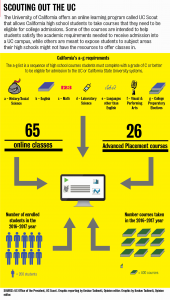California boasts the best public university system in the country. But tell that to the out-of-state students who don’t have a chance to attend a University of California because their high school doesn’t offer them courses that would help them meet the UC’s minimum admission requirements.
The University of California created the Scout program in 2013, which allows California high school students to take online courses to meet the minimum enrollment criteria to attend a UC. High school students can take 65 online college prep courses, including A-G requirement courses, which are the sequence of courses required for admission at a UC or California State University campus, and Advanced Placement classes.
Basic enrollment in the Scout program allows access to the online preparatory courses at no charge for state public school students and for a fee for private school or out-of-state students. The program charges different fees for the courses it offers based on the scheduled time assigned for the course and if an official Scout instructor is included.
While these online college prep courses make the A-G courses easily accessible to many students within the California public school system, out-of-state students are left out of the deal. The UC has only given free access to the Scout program to California public high school students, despite the fact that out-of-state high school students are often at a disadvantage in applying to the UC because high school graduation requirements vary from state to state and don’t necessarily correspond with the A-G requirements.
The UC needs to standardize the fee access to the Scout program among in-state and out-of-state public school students. Out-of-state and international students deserve a fair shot at attending the nation’s top public university system.
UC President Janet Napolitano said the Scout program was created for students who attend schools with limited resources, according to a UC Newsroom report. While California high school graduation requirements adhere closely to the A-G requirements needed for UC admissions, such as two years of history and science and one year of college prep electives, students from schools with limited resources often don’t have access to AP classes – sometimes not even A-G required courses. The UC identified that 47 California high schools do not offer the full spectrum of required courses.
The Scout program helps address these academic inequities. It easily lays out how students can satisfy the UC’s A-G requirements, as well as take AP classes, and gives them the opportunity to build a relationship with a mentor, either their high school teacher or a Scout instructor.
These are facilities the UC should also provide to out-of-state students for an equivalent cost. Nonresident students are already fighting an uphill battle, given A-G requirements for California’s universities aren’t something non-California high schools are likely to discuss. Low-income nonresident students are even more at a disadvantage, since they are less likely to have access to the courses, such as the AP courses offered by UC Scout, needed to have a chance at being admitted to a UC campus.
Yet, UC Scout charges a baseline of $19 per course for an out-of-state student, in its Basic plan. If an out-of-state school wants to enroll more than one student in a single course, the UC charges $99 plus $19 per student enrolled – even if the material is being used just to supplement course curricula. For a low-income student whose school doesn’t offer the full spectrum of courses that satisfy A-G requirements – let alone AP classes – and doesn’t have the money to enroll in Scout, this is a death knell for the dream of attending a UC.
If the overall goal of the program is to close the achievement gap, Scout shouldn’t limit its accessibility to low-income students in California.
Distributing the cost of the Scout program among in-state and out-of-state students isn’t unreasonable. The UC could certainly provide application waivers for Californians who cannot afford the program, but that shouldn’t preclude out-of-state students from being able to even strive for a UC education.
An obvious route in-state or out-of-state students can take to fulfill their A-G requirements, other than taking courses in high school, is to take courses at a local community college. However, this can be inconvenient for students who don’t have a reliable form of transportation, and students would have to set aside time to take college classes, which would cut into their existing schoolwork or extracurricular activities. A cheap and readily accessible alternative can aid out-of-state students just as much as it aids in-state students.
And sure, the expansion of Scout this year was made possible with $4 million from the California government – taxpayer dollars. And the Scout program gives in-state students a well-deserved advantage.
But the UC is a global institution. Students across the nation, not just in California, dream of attending schools like UCLA. It’s an educational marketplace that extends beyond California’s borders. Students shouldn’t have to cut their aspirations short just because their high schools don’t offer certain courses.

